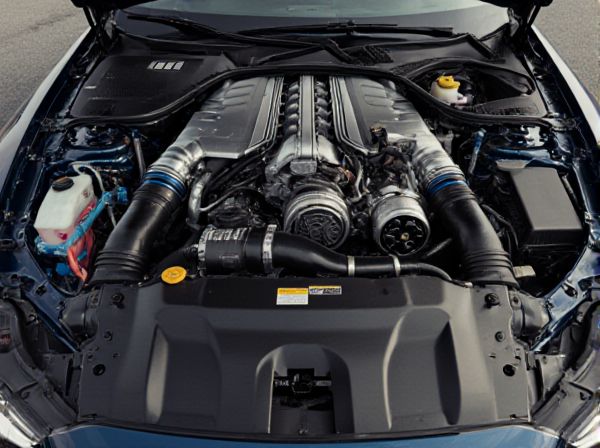
Photo illustration: Supercharged Engine vs Turbocharged Engine
A supercharged engine delivers instant power by mechanically forcing more air into the combustion chamber, providing immediate throttle response and increased horsepower. Turbocharged engines use exhaust gases to spin a turbine that compresses air, improving efficiency and performance, especially at higher RPMs. Your choice depends on whether you prioritize rapid acceleration or fuel efficiency and smooth power delivery.
Table of Comparison
| Feature | Supercharged Engine | Turbocharged Engine |
|---|---|---|
| Boost Mechanism | Driven by engine crankshaft (belt-driven) | Powered by exhaust gas turbine |
| Lag | Immediate boost response | Turbo lag due to spool-up delay |
| Power Delivery | Consistent and linear boost | Variable boost, depends on engine speed |
| Fuel Efficiency | Less fuel efficient, higher parasitic loss | More fuel efficient, utilizes exhaust energy |
| Complexity and Cost | Simple design, lower cost | More complex, higher maintenance cost |
| Heat Management | Generates less heat compared to turbo | Higher exhaust heat, requires efficient cooling |
| Common Applications | Muscle cars, performance vehicles | Modern fuel-efficient and high-performance cars |
Introduction to Forced Induction Engines
Forced induction engines increase engine efficiency and power output by compressing incoming air before it enters the combustion chamber. Supercharged engines use a belt-driven compressor connected to the crankshaft, providing immediate boost and improved throttle response. Turbocharged engines rely on exhaust gases to spin a turbine, offering higher efficiency and greater power potential at higher engine speeds.
How Supercharged Engines Work
Supercharged engines operate by using a belt-driven compressor connected directly to the engine's crankshaft, forcing more air into the combustion chamber to increase power output instantly. This method provides immediate boost without the lag traditionally associated with turbochargers, enhancing throttle response and low-end torque. The direct mechanical connection ensures consistent airflow and pressure, making superchargers ideal for performance applications requiring quick acceleration.
How Turbocharged Engines Work
Turbocharged engines use a turbine-driven forced induction system that harnesses exhaust gases to spin a turbine connected to a compressor, which forces additional air into the combustion chamber. This increased air intake allows for more fuel combustion, resulting in higher power output and improved engine efficiency without significantly increasing engine size. Turbochargers reduce lag by rapidly spooling at high RPMs, making them highly effective for enhancing performance in both gasoline and diesel engines.
Performance Comparison: Power Delivery
Supercharged engines deliver immediate power through a belt-driven compressor, providing consistent boost and low-end torque without lag, ideal for rapid acceleration. Turbocharged engines rely on exhaust gases to spin a turbine, resulting in variable power delivery with slight lag but greater efficiency at higher RPMs and increased peak power. The choice affects acceleration dynamics: superchargers enhance throttle responsiveness, while turbochargers maximize top-end performance and fuel economy.
Fuel Efficiency: Supercharger vs Turbocharger
Supercharged engines typically consume more fuel due to their direct mechanical connection to the crankshaft, which continuously draws power regardless of engine load, reducing overall fuel efficiency. Turbocharged engines utilize exhaust gases to spin the turbine, enhancing air intake without additional engine drag, resulting in better fuel economy under most driving conditions. Therefore, turbochargers are generally more fuel-efficient compared to superchargers, especially in vehicles designed for optimal fuel consumption.
Maintenance and Longevity Considerations
Supercharged engines typically require more frequent maintenance due to their mechanical belt-driven system, which places additional strain on engine components and may lead to faster wear. Turbocharged engines, while benefiting from exhaust-driven boost that reduces direct engine load, demand careful attention to oil quality and cooling systems to prevent heat-related damage and ensure longevity. Proper and timely maintenance, including regular oil changes and inspection of boost-related parts, is crucial for maximizing the lifespan of both supercharged and turbocharged engines.
Cost Analysis: Installation and Upkeep
Supercharged engines typically have higher installation costs due to their mechanical complexity and direct connection to the engine's crankshaft, which can increase labor time and parts needed. Turbocharged engines, while often cheaper to install because they utilize exhaust gases for power, may incur higher upkeep expenses related to maintaining the turbocharger's turbine and intercooler system. Long-term maintenance costs for superchargers tend to be lower since they have fewer bespoke components, but turbochargers can require expensive repairs if oil quality or cooling systems fail.
Driving Experience and Throttle Response
Supercharged engines offer immediate throttle response and consistent power delivery due to the direct mechanical connection to the crankshaft, enhancing acceleration in low RPM ranges. Turbocharged engines rely on exhaust gases to spool the turbine, which can introduce a slight delay known as turbo lag but generally provide higher peak power and improved efficiency at higher RPMs. Drivers seeking instant throttle response and linear power prefer superchargers, while those prioritizing fuel economy and maximum power often choose turbochargers for their dynamic driving experience.
Environmental Impact and Emissions
Supercharged engines typically generate more direct power by mechanically compressing air, leading to increased fuel consumption and higher CO2 emissions compared to turbocharged engines, which use exhaust gases to boost intake air, enhancing fuel efficiency. Turbocharged engines reduce environmental impact by maximizing energy recovery from exhaust, resulting in lower greenhouse gas emissions and improved fuel economy. Consequently, turbocharged technology is favored for its emission benefits and better compliance with stringent environmental regulations.
Choosing the Right Option: Supercharged vs Turbocharged
Choosing between a supercharged engine and a turbocharged engine depends on performance needs and driving style; superchargers provide immediate power with no lag due to their direct belt-driven mechanism, ideal for low-end torque and consistent acceleration. Turbocharged engines use exhaust gases to spool a turbine, offering better fuel efficiency and higher peak power but with slight turbo lag, making them suitable for high-rev, performance-oriented applications. Understanding these differences helps optimize vehicle performance based on responsiveness, fuel economy, and intended use scenarios.
 caratoz.com
caratoz.com